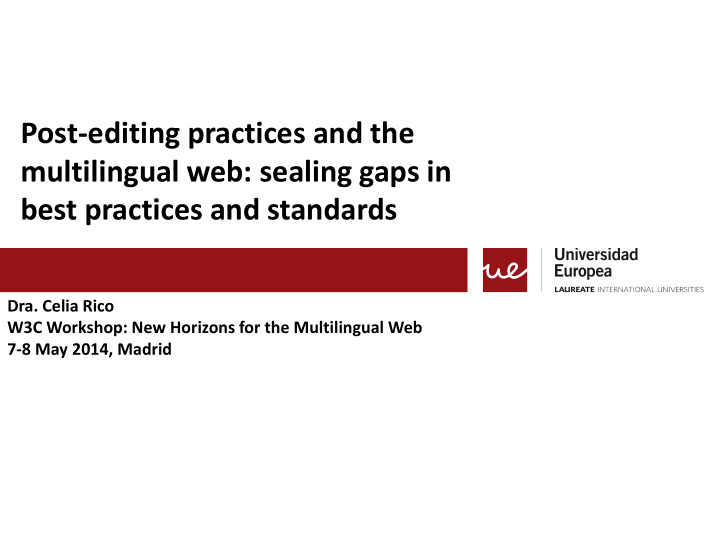



Post-editing practices and the multilingual web: sealing gaps in best practices and standards Dra. Celia Rico W3C Workshop: New Horizons for the Multilingual Web 7-8 May 2014, Madrid
Dra. Celia Rico, celia.rico@uem.es
Dra. Celia Rico, celia.rico@uem.es
Dra. Celia Rico, celia.rico@uem.es
The case for Post-editing as multilingual Web enabler
Dra. Celia Rico, celia.rico@uem.es
Source: Trends in Machine Translation , Common Sense Advisory, 2011 “ 150-200% more words Using Machine Translation and Post-Editing instead of human translation when working with a translation agency could mean translating 150- 200% more words for the same money ”
Dra. Celia Rico, celia.rico@uem.es
At some point you need a person checking MT output! Post-production? – No post-editing : internal documentation, browsing, gisting, tightly controlled languages, KBs with customised MT – Rapid post-editing : perishable information and urgent texts (only serious errors are fixed) – Partial post-editing : minimum changes – Full post-editing : complete revision (external publication) Dra. Celia Rico, celia.rico@uem.es
Post-editing and ITS 2.0
ITS 2.0 • Facilitating automated creation and processing of web content • Defining metadata for language technology in the Web (MT, Localization) • Metadata needed for web content (HTML5), deep Web (XML), Localization formats (XLIFF) Adding value to content Dra. Celia Rico, celia.rico@uem.es
http://www.mtsummit2013.info/files/proceedings/main/mt-summit-2013-rico-et-al.pdf What info? ITS 2.0 metatags were reviewed in terms of PE needs
http://www.localisation.ie/resources/locfocus/LocalisationFocusVol11_1Web.pdf Post-editing information
Dra. Celia Rico, celia.rico@uem.es
ITS 2.0 data categories Dra. Celia Rico, celia.rico@uem.es
Mapping tags and rules Data PE purposes PE rule activation category Translate Informing the post-editor of sentences or Block text when NO post- sentence fragments should or should not be editing is to be done translated Localization Providing post-editors with the necessary Trigger PE rules (from zero to note information to review the text in order to help full PE) according to text them disambiguate and improve the quality functionality, delivery time and and accuracy of the revision. importance of brand image Utility (relative importance of the functionality (O’Brien, 2012; Rico, 2012) of the translated content). Delivery Time (speed with which the translation is required). Sentiment (importance on brand image). Language Points to part of content in a language different Block text when NO post- information from the rest, which could require MT and editing is to be done post-editing for a specific language pair. Domain It enables automatic selection of MT Check domain & disambiguate terminology, post-editor selection, and is a key when necessary to content disambiguation.
Mapping tags and rules Data PE purposes PE rule activation category Provenance Assessing how translation agents may impact Confirm provenance the quality of the translation. Translation and translation revision agents can be identified as a person, a piece of software or an organization that has been involved in providing a translation that resulted in the selected content. Localization Detecting possible localization issues such as: Trigger PE rules accordingly quality issue Terminology, Mistranslation, Omission, Untranslated, Addition, Duplication, Grammar, Legal, Register, Locale specific content, Locale violation, Style, Characters, Misspelling… MT Confidence score for each translated segment. Prevent text modification above Confidence Those above a certain thresold will be blocked a certain thresold for no post-editing
Maximising the post- editor’s interface Dra. Celia Rico, celia.rico@uem.es
Conclusion There is a case for At some point you Post-editing as a need a person multilingual web checking MT enabler output ITS 2.0 facilitates Keep it clean and automation simple Dra. Celia Rico, celia.rico@uem.es
References Bikmatov, R., N. Glenn , S. Gladkoff, A. Melby (2013): “V isualization of ITS 2.0 Metadata for Localization Process”, Localization Focus , vol. 12, 1: 74-77 Moorkens, J, and s. O’Brien , 2013: “ User Attitudes to the Post-Editing Interface” Sharon O’Brien, Michel Simard and Lucia Specia (eds .): Proceedings of MT Summit XIV Workshop on Post-editing Technology and Practice , Nice, September 2, 2013, p. 19 – 25. O’Brien, S. (2012) “Towards a Dynamic Quality Evaluation Model for Translation” The Journal of Specialised Translation , Issue 17, Jan. 2012 Rico, C. and Díez Orzas, P.L. (2013): “EDI -TA: Training methodology for Machine Translation Post- editing ”, Multilingualweb-LT Deliverable 4.1.4. Annex II , public report, Available: http://www.w3.org/International/multilingualweb/lt/wiki/images/d/d4/D4.1.4.Annex_II_EDI- TA_Training.pdf [05/05/2014] Rico, C. adn Díez Orzas, P.L. (2013): “EDI -TA: Post-editing methodology for Machine Translation ”, Multilingualweb-LT Deliverable 4.1.4. Annex I , public report, Available: http://www.w3.org/International/multilingualweb/lt/wiki/images/1/1f/D4.1.4.Annex_I_EDI- TA_Methology.pdf [05/05/2014] Rico, C., P.L. Díez Orzas and F. Sasaki (2013): “ Implementing ITS 2.0 for post-editing purposes ”, Proceedings of the MT Summit 2013, 2-6- Sept. Nice, France. http://www.mtsummit2013.info/files/proceedings/main/mt-summit-2013-rico-et-al.pdf [05/05/2014] Rico , C. (2012): “A Flexible Decision Tool for Implementing Post -editing Guidelines ”, Localisation Focus , vol. 11, 1: 54-66 http://www.localisation.ie/resources/locfocus/LocalisationFocusVol11_1Web.pdf [05/05/2014] Dra. Celia Rico, celia.rico@uem.es
Recommend
More recommend